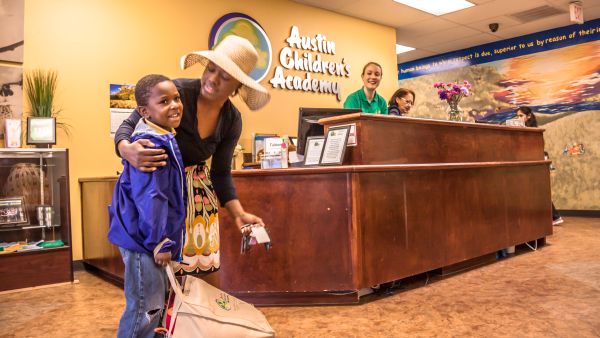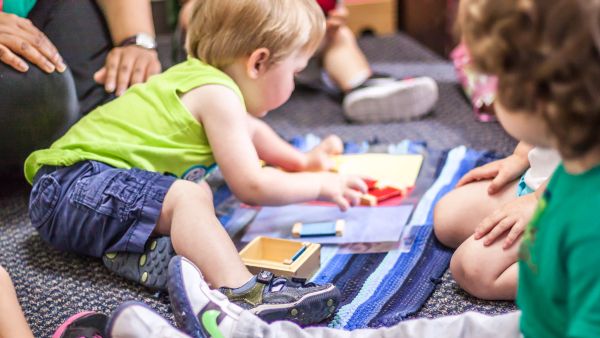
Oh, for the long, lazy days of your child’s early years, of free play in the local playground, of blanket forts in the family room during rainy days, of spur-of-the-moment neighborhood picnics, and naps on demand.
Hold onto those memories, folks. Preschool looms, and many would have you think that it’s time to take out the number 2 pencil, and the paddle.
Fear Of Failure
Perhaps your neighbors are talking about the relative benefits of Montessori, Reggio Emilia, Waldorf, or faith-based educational philosophies, while you thought you’d simply sign your child up for the homey co-op down the street. Perhaps they’re gushing over an amazing, highly-accredited facility fifteen miles away that costs tens of thousands in tuition and has walls papered with photos of graduates who went on to become titans of commerce.
While Junior sits on your lap spitting watermelon seeds onto the grass, you’re suddenly envisioning the arc of those seeds flying over the cavernous wage gap between high school and college graduates.
You tighten your grip on the stem of your wine glass. If you fumble this choice about preschool, will Junior be forever behind?
Just The Facts, Ma’am
The truth is that all children benefit from a high-quality preschool education, but despite the claims of many high-pressure, low-admission-rate schools, stuffing heads is not a fundamental goal of early childhood education. Preschool is the time for social, emotional, and cognitive development. It’s a time to nurture independence. It’s all about learning to follow directions, play well with others, and develop curiosity in the great, wide world. Organic gardens are a fun outdoor activity, Mandarin classes are an intriguing perk, and gourmet hot lunches very healthy, but any well-run, accredited preschool with educated, caring teachers can achieve these basic goals.
So if you’re in the market for a preschool, the first thing to do is to finish your glass of wine. Then take a deep breath. The perfect preschool is out there, and enrolling your child in it won’t break the bank.
Be An Early Bird
If you’re a Manhattanite looking to get your three-year-old into one of the city’s $40,000-a-year private preschools, you’re already too late. Many high income families in Type-A cities hire private counselors to ferry them through the process while their kids are still crawling.
Just wait until your child applies to college.
Yet even if you aren’t facing a serious shortage in quality preschools, starting the process early is always a good idea. Many preschools hold open houses in the late fall or early winter before the next academic session. If you miss that window, try scheduling a private tour. Some schools may have a formal application process with rigid dates and even interviews and tests for your child, so it’s to your advantage to start the shopping early. Just keep in mind that many quality preschools also work on a rolling admissions basis so long as your child is potty-trained.
Nail Down The Basics
You may be able to rule out a multiplicity of preschools by simply taking stock of your own situation. The relevant factors boil down to cost, distance, and time.
Check your finances before you commit to a bank-breaking tuition, even if you can afford it. For decades, college costs have been rising faster than inflation. Would it serve your child better to put that money in a 529 account or other higher-education investment vehicle?
Secondly, consider how the drop-off/pick-up times are going to affect your ability to get to and from work. Some preschools provide transportation in the form of a small school bus, but most put that onus on you. Schools may charge you fees for late pick-up, so make sure you can comfortably conform to the schedule. Consider the value of your time as well. Preschool co-ops tend to be cheaper, but can you afford the time off of work to spend required hours in the classroom?
Finally, consider the hours available at the preschool and how they mesh with your schedule. Preschools may be half-day or full-day. They may offer after-hours child care. Consider that they often work on the same academic calendar as the local public schools. That means they’ll have weeks of holiday vacations and probably a dozen other days off during the academic year. Do you have a secure childcare arrangement for these gaps? Does the preschool have a summer camp where you can send your child during those months? Will you have to continue to pay childcare while also paying for preschool, or are you looking to change over altogether?
If going to a supposedly fabulous preschool means extra stress, extra cost, and extra childcare, choose sanity.
The Bare Necessities
Check, too, the licensing and longevity of the preschool. Longevity is a sign that the preschool has been pleasing generation after generation of parents and children. Licensing by the state is an assurance that the school is up to code when it comes to health and safety. It can’t hurt to get a look at the license to make sure it’s up-to-date.
Time To Philosophize
Preschools come in a variety of educational and religious philosophies, so it helps to understand the more common ones in order to decide which will work best for your child.
Waldorf schools are teacher-directed and play-based. There are never any grades or testing and the emphasis is on creative play. Engaging in outdoor activities, whether rain or shine, is one of the philosophies’ particular quirks. The classrooms have mixed ages to mimic the home setting, and usually the kids have the same teacher through the years they are in the school. Parents frazzled by their kids’ fascination with screens will love the fact that electronic media is verboten in the classroom.
Reggio Emilia-inspired preschools are highly creative, child-directed, and project-based. In deference to their artistic bent, the schools tend to be uncluttered spaces filled with light. A child may spend days, weeks, even months exploring a particular interest, like flowers or rocks. The child’s progress tends to be documented by artwork in a variety of media, brought together in a portfolio.

Montessori schools are also child-centered and play-based. The school is full of specially designed, enticing educational toys that encourage child-directed advancement. The emphasis is on nurturing curiosity and a love of learning. The groups in a classical Montessori school tend to be larger and of mixed ages, encouraging a family-like atmosphere where the older children enjoy acting as mentors to the younger ones, with the younger ones growing into that role as time goes on.
Some scientific studies suggest kids with a Montessori education do receive a slight academic edge in memory, reading, and vocabulary skills as well as social skills like sharing and fairness.
Prepare The Hard Questions
Before you visit the school, be prepared with a list of smart questions to ask the principal and faculty.
• What Are The Teacher Credentials? Preschool teachers should have at least two years of college in the area of early childhood development. They should also be CPR certified and trained in basic first aid. The head teacher should have a college degree in the same field. Ask the head of the school about teacher turnover. Overworked or underpaid staff tend to move on to better positions, so high turnover may be an indication of trouble. Do keep in mind that many aspiring kindergarten teachers do their training hours in preschool, so turnover alone is not always a red flag. Finally, check the teacher/student ratio. For toddlers ages two to three, the recommendation is 1:8, for children four to five years old, the recommendation is 1:10.
• What Are The Rules? Every preschool should have guidelines that organize how the school should be run. What are the drop-off and pick-up times? Are parents allowed to linger, and if so, how long? When are children allowed back in school after sickness, and is immunization required? If medicine needs to be dispensed during the day, how is that arranged? How are mealtimes handled? If food is provided, what choices, if any, do the children have? May they bring their own food, and are there any restrictions on what they can bring? What kind of allowances does the school make for food allergies?
• What is your philosophy on discipline and conflict resolution? What would the teacher do if one child bit, pushed, or punched another child? How does the school approach issues of bullying? How do they handle a child throwing a tantrum? How do they comfort a child who is crying?
• What kind of feedback will I receive about my child’s day as well as overall development? Does the preschool provide a daily, weekly, or monthly log of what the child has accomplished? Are there weekly worksheets or tests? Are there parent-teacher conferences every semester? Are the teachers available for conferences? Is there a parent-school newsletter?
• What will be my child’s routine? Asking about the schedule will give you an insight in how much time is spent in active, large-motor skill play, in reading, in creative activities, in naps and in mealtime. Is there any unrestricted time where the children can choose what they want to do themselves?
The Vaunted Visit
Once you’ve pared down your choices to those that fit your budget, schedule, and philosophical priorities, it’s time to schedule a visit, preferably while the school is in session. If you still haven’t made a decision about preschools, you may prefer to take this tour without your child. She may be put off by an aggressive student having a bad day, or she may be enchanted by a particular swing set in what is otherwise an unsuitable environment. Take this time to ask questions and also to observe the facilities and the teacher-student interactions to make sure it meets your standards first.
Facilities. Is the building well-maintained? Are the rooms clean, bright, inviting, with plenty of room for the students inside?
Teacher-Student Interactions. Watch the students in action. Do they seem to be wandering aimlessly? Are they being forced to sit still for long periods of time? Do they seem happy, engaged? Is there a variety of activities evident, like beanbag chairs near a bookshelf, buckets of crayons and paper, building blocks? Watch the teachers in action. Do they spend more time with one child or another, or do they wander the room? Are they guiding the activities or are they giving the children leave to make choices? How do the teachers handle the inevitable outbursts and sharing conflicts? How do they handle crying?
Trust Your Instincts
Keep in mind that hard-to-get-into schools with long waiting lists that brag about their accomplished graduates feed into every parent’s fear that making one wrong decision about their four-year-old will reverberate throughout their life. Frankly, not getting into Miss Smarty Pants’ Peerless Progressive Preschool doesn’t mean Harvard is forever out of reach.
Trust your instincts. Most of all, don’t be afraid to let your children learn by playing for just a little longer.
After all, college is right around the corner.
















